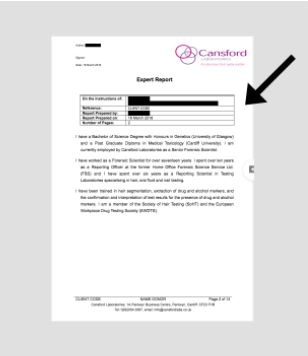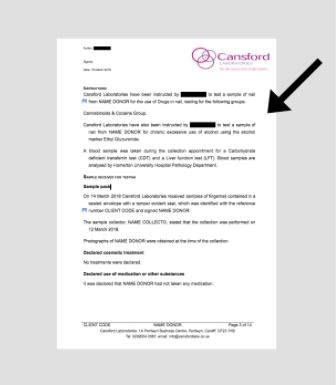CANSFORD LABS
Comprehensive Guide: How to read your Cansford test results report
on May 3, 2018
When it comes to test results, our clients often ask us similar questions. Which substances did the donor use? If so, was their use excessive, and how have their consumption levels changed from month to month?
Where possible, we provide answers to these questions in our laboratory test results reports.
These documents are designed to be simple, clear and comprehensive, to reflect the importance of correctly interpreting test results in cases involving both individuals and families.
Importantly, the results reports provided by our team can be used as evidence in UK courts.
Below, we’ve provided a full breakdown of each section of our results report, including details of what each section means and why this is important.
Title page: Expert report

This section acts as a reference point for the report – to enable clients with multiple reports find the right document. More importantly, the text sets out the professional experience, qualifications and accreditations of the toxicologist who is preparing and interpreting the report. This information is needed to validate the scientist that is preparing the report as an expert witness.
Instructions

This section confirms the instructions received by the laboratory from the client, including which substances they wanted to test for, the types of test they requested and – if necessary – which other laboratories, lawyers or social services were involved in the analysis.
This page, therefore, sets out the rationale for the test, as understood by the toxicologist. This is important because the reason for the test will affect the type of analysis the laboratory performs, and therefore their interpretation of the test results. For more on the interpretation of results, click here.
Sample received for testing
This section notes the condition and nature of the sample received, to confirm that the chain of custody for the sample is unbroken.
The section also sets out any cosmetic treatment applied to the sample – for example, bleaching agents on strands of hair – and claims made by the donor about their substance use.
This is important because certain chemicals, like bleach or medication, affect test results. The donor’s claim about which substances they used, and when, provides the context for the toxicologist's interpretation of the results of the sample.
Explanation of the analytical steps in the laboratory
This section sets out the exact process performed by the laboratory to arrive at their interpretation and conclusions of the analysis results.
The section covers the toxicologist’s treatment of the sample; how their analytical method (for example, liquid chromatography with mass spectrometry) works; how cut-offs affect their interpretation of the results; the estimated period covered by the results, and any extenuating circumstances around the sample or their analysis that might have affected the results offered.
This information is the type most often cross-examined in court, where the credibility of the witness or the test method itself is questioned. It is essential for the client to understand each point so that they are aware of the nature and limitations of the test and test result.
Accession of the sample collected from [Name]
This sets out the length of the sample, and the date the sample was received.
This is significant because the sample length affects the detection window offered by the test. For example, human hair grows at a rate of around 1cm each month, so that sectional analysis of a 1cm sample indicates substance use over one month. For more on this, click here.
Analysis results
This section states which drug or alcohol substance groups were detected (or not) in the sample.
Explanation of the groups
This section explains in detail the chemical markers detected, and which drug or alcohol substance groups these belong to – for example, THC in cannabis. This provides additional detail for cross-examination in court.
This section also includes the results of any secondary tests conducted – in this example, Liver Function Tests (LFTs) and Carbohydrate Deficient Transferrin (CDT) tests of a blood sample.
Where possible, this section will indicate the levels of the substance detected, in comparison with the levels detected in other samples at Cansford Labs. It’s important to note that the levels detected do not reflect the amount of drugs or alcohol used by the donor. It is not possible to provide an accurate indication of the amount of substance used – despite what other laboratories claim – for the reasons outlined in our article here.
Conclusions and interpretations
This crucial section offers the toxicologist’s interpretation of the test results, and how these relate to the claims made by the donor about their substance use. Where possible, our conclusion will state:
- Whether the donor used or did not use a named substance within an estimated timeframe, and whether their level of use was within low, medium or high ranges indicated by other positive samples.
- Whether their substance use was chronic or sporadic over the estimated time frame, or why the type of test performed cannot offer this information.
- If the test was performed in multiple segments, we might give an indication whether drugs were used on more than one occasion.
- Whether any additional circumstances affected the test result and the accuracy of the result – for example, if the hair sample was bleached before testing – and whether this should affect the judgement reached about the donor’s substance use.
- For alcohol tests, how the donor’s substance use compares to averages offered by the WHO (World Health Organisation) and other medical bodies, and contextual information around these averages – for example, the number of units of alcohol included in different measures of alcohol.
References
This section provides links to additional academic research used to corroborate the report findings, including information on the tests performed, the results offered and extenuating circumstances that could affect those results.
Experts’ declaration
This section of the report confirms that the author has fulfilled all conditions necessary for the report to be used as an expert witness in court.
This includes confirmation that, in their analysis, the author has performed their duties as required by the court; that they have offered a true judgement as they understand it; that the report confirms to the standards required of an expert witness; that there exist no conflicts of interest around the test process and results offered, and that the author holds the qualifications necessary to act as an expert witness.
You may still have questions about your test results
While our reports are intended to offer all the information necessary to help close your case, you may still have questions about your test results. In this case, please contact the Cansford Labs team member with whom you set up the test, who will be happy to offer additional support.
Understanding the types of data provided by different tests is essential to building a conclusive case. Find out more about the advantages and disadvantages of hair testing with our article: Building a Picture of Substance Use.

Lolita Tsanaclis
Dr. Lolita Tsanaclis, Chief Scientific Officer of Cansford Laboratories Limited, has been developing methods for the analysis of drugs in hair since 1993. She has been involved in drug testing using hair, blood and oral fluid samples for medico-legal and workplace sectors for over three decades. Dr Tsanaclis is published extensively as author and as co-author in highly regarded peer-reviewed publications and scientific presentations.


